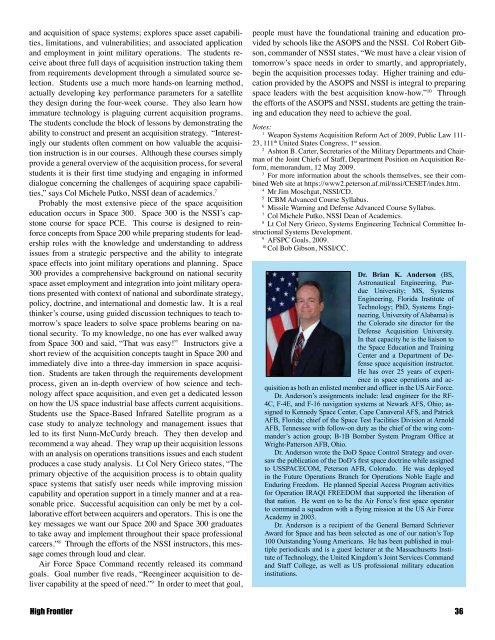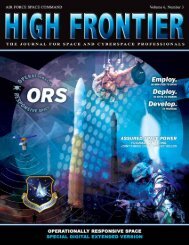Space Acquisition - Air Force Space Command
Space Acquisition - Air Force Space Command
Space Acquisition - Air Force Space Command
Create successful ePaper yourself
Turn your PDF publications into a flip-book with our unique Google optimized e-Paper software.
and acquisition of space systems; explores space asset capabilities,<br />
limitations, and vulnerabilities; and associated application<br />
and employment in joint military operations. The students receive<br />
about three full days of acquisition instruction taking them<br />
from requirements development through a simulated source selection.<br />
Students use a much more hands-on learning method,<br />
actually developing key performance parameters for a satellite<br />
they design during the four-week course. They also learn how<br />
immature technology is plaguing current acquisition programs.<br />
The students conclude the block of lessons by demonstrating the<br />
ability to construct and present an acquisition strategy. “Interestingly<br />
our students often comment on how valuable the acquisition<br />
instruction is in our courses. Although these courses simply<br />
provide a general overview of the acquisition process, for several<br />
students it is their first time studying and engaging in informed<br />
dialogue concerning the challenges of acquiring space capabilities,”<br />
says Col Michele Putko, NSSI dean of academics. 7<br />
Probably the most extensive piece of the space acquisition<br />
education occurs in <strong>Space</strong> 300. <strong>Space</strong> 300 is the NSSI’s capstone<br />
course for space PCE. This course is designed to reinforce<br />
concepts from <strong>Space</strong> 200 while preparing students for leadership<br />
roles with the knowledge and understanding to address<br />
issues from a strategic perspective and the ability to integrate<br />
space effects into joint military operations and planning. <strong>Space</strong><br />
300 provides a comprehensive background on national security<br />
space asset employment and integration into joint military operations<br />
presented with context of national and subordinate strategy,<br />
policy, doctrine, and international and domestic law. It is a real<br />
thinker’s course, using guided discussion techniques to teach tomorrow’s<br />
space leaders to solve space problems bearing on national<br />
security. To my knowledge, no one has ever walked away<br />
from <strong>Space</strong> 300 and said, “That was easy!” Instructors give a<br />
short review of the acquisition concepts taught in <strong>Space</strong> 200 and<br />
immediately dive into a three-day immersion in space acquisition.<br />
Students are taken through the requirements development<br />
process, given an in-depth overview of how science and technology<br />
affect space acquisition, and even get a dedicated lesson<br />
on how the US space industrial base affects current acquisitions.<br />
Students use the <strong>Space</strong>-Based Infrared Satellite program as a<br />
case study to analyze technology and management issues that<br />
led to its first Nunn-McCurdy breach. They then develop and<br />
recommend a way ahead. They wrap up their acquisition lessons<br />
with an analysis on operations transitions issues and each student<br />
produces a case study analysis. Lt Col Nery Grieco states, “The<br />
primary objective of the acquisition process is to obtain quality<br />
space systems that satisfy user needs while improving mission<br />
capability and operation support in a timely manner and at a reasonable<br />
price. Successful acquisition can only be met by a collaborative<br />
effort between acquirers and operators. This is one the<br />
key messages we want our <strong>Space</strong> 200 and <strong>Space</strong> 300 graduates<br />
to take away and implement throughout their space professional<br />
careers.” 8 Through the efforts of the NSSI instructors, this message<br />
comes through loud and clear.<br />
<strong>Air</strong> <strong>Force</strong> <strong>Space</strong> <strong>Command</strong> recently released its command<br />
goals. Goal number five reads, “Reengineer acquisition to deliver<br />
capability at the speed of need.” 9 In order to meet that goal,<br />
people must have the foundational training and education provided<br />
by schools like the ASOPS and the NSSI. Col Robert Gibson,<br />
commander of NSSI states, “We must have a clear vision of<br />
tomorrow’s space needs in order to smartly, and appropriately,<br />
begin the acquisition processes today. Higher training and education<br />
provided by the ASOPS and NSSI is integral to preparing<br />
space leaders with the best acquisition know-how.” 10 Through<br />
the efforts of the ASOPS and NSSI, students are getting the training<br />
and education they need to achieve the goal.<br />
Notes:<br />
1<br />
Weapon Systems <strong>Acquisition</strong> Reform Act of 2009, Public Law 111-<br />
23, 111 th United States Congress, 1 st session.<br />
2<br />
Ashton B. Carter, Secretaries of the Military Departments and Chairman<br />
of the Joint Chiefs of Staff, Department Position on <strong>Acquisition</strong> Reform,<br />
memorandum, 12 May 2009.<br />
3<br />
For more information about the schools themselves, see their combined<br />
Web site at https://www2.peterson.af.mil/nssi/CESET/index.htm.<br />
4<br />
Mr Jim Moschgat, NSSI/CD.<br />
5<br />
ICBM Advanced Course Syllabus.<br />
6<br />
Missile Warning and Defense Advanced Course Syllabus.<br />
7<br />
Col Michele Putko, NSSI Dean of Academics.<br />
8<br />
Lt Col Nery Grieco, Systems Engineering Technical Committee Instructional<br />
Systems Development.<br />
9<br />
AFSPC Goals, 2009.<br />
10<br />
Col Bob Gibson, NSSI/CC.<br />
Dr. Brian K. Anderson (BS,<br />
Astronautical Engineering, Purdue<br />
University; MS, Systems<br />
Engineering, Florida Institute of<br />
Technology; PhD, Systems Engineering,<br />
University of Alabama) is<br />
the Colorado site director for the<br />
Defense <strong>Acquisition</strong> University.<br />
In that capacity he is the liaison to<br />
the <strong>Space</strong> Education and Training<br />
Center and a Department of Defense<br />
space acquisition instructor.<br />
He has over 25 years of experience<br />
in space operations and acquisition<br />
as both an enlisted member and officer in the US <strong>Air</strong> <strong>Force</strong>.<br />
Dr. Anderson’s assignments include: lead engineer for the RF-<br />
4C, F-4E, and F-16 navigation systems at Newark AFS, Ohio; assigned<br />
to Kennedy <strong>Space</strong> Center, Cape Canaveral AFS, and Patrick<br />
AFB, Florida; chief of the <strong>Space</strong> Test Facilities Division at Arnold<br />
AFB, Tennessee with follow-on duty as the chief of the wing commander’s<br />
action group; B-1B Bomber System Program Office at<br />
Wright-Patterson AFB, Ohio.<br />
Dr. Anderson wrote the DoD <strong>Space</strong> Control Strategy and oversaw<br />
the publication of the DoD’s first space doctrine while assigned<br />
to USSPACECOM, Peterson AFB, Colorado. He was deployed<br />
in the Future Operations Branch for Operations Noble Eagle and<br />
Enduring Freedom. He planned Special Access Program activities<br />
for Operation IRAQI FREEDOM that supported the liberation of<br />
that nation. He went on to be the <strong>Air</strong> <strong>Force</strong>’s first space operator<br />
to command a squadron with a flying mission at the US <strong>Air</strong> <strong>Force</strong><br />
Academy in 2003.<br />
Dr. Anderson is a recipient of the General Bernard Schriever<br />
Award for <strong>Space</strong> and has been selected as one of our nation’s Top<br />
100 Outstanding Young Americans. He has been published in multiple<br />
periodicals and is a guest lecturer at the Massachusetts Institute<br />
of Technology, the United Kingdom’s Joint Services <strong>Command</strong><br />
and Staff College, as well as US professional military education<br />
institutions.<br />
High Frontier 36











